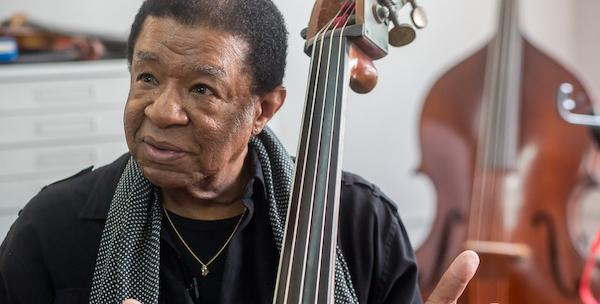Film Review: “Buster Williams: Bass to Infinity” — Portrait of a Jazz Artist
By Steve Provizer
This fine documentary of a highly respected elder bassist presents a clear, focused picture of a man who is also a jazz musician.
Buster Williams: Bass to Infinity, directed by Adam Kahan

Buster Williams in a scene from Buster Williams: Bass to Infinity.
Films about jazz musicians come along that have been well financed and include wonderful performances. Yet, when I review them, I feel like the guy at the end of the circus parade tasked with sweeping up after the elephants. It may have been a hell of a show, but there’s a lot of crap that needs to be cleaned up. There’s nothing revelatory about Buster Williams:Bass To Infinity, but it’s a good feeling to watch a film about jazz where nothing ridiculous happens. This is a film that requires no cleanup. It gives us a clear, focused picture of a man who is also a jazz musician.
It’s emblematic of the approach of director Adam Kahan that nothing feels “set up” about the locations in the film. The documentary unfolds in the spaces where Williams spends his days: his apartment, practicing bass and chanting; lofts or vacant clubs, rehearsing with other musicians during the day; a bass store, talking shop, and in performance at nightclubs. People talk, but there are no talking heads. No one talks about Buster; they talk with him. He comes across as a sincere, emotionally open person. And, despite sticking to real locations, the filmmaking crew delivers good-looking cinematography and excellent sound.
If you know anything about the history of jazz over the last 50 years, you probably know the name Buster Williams. He began gigging in his teens with Sonny Stitt and Gene Ammons, and he went on to work with Herbie Hancock, Miles Davis, Sarah Vaughan, Nancy Wilson, and many others. Eventually, he led groups and recordings himself.
We hear Williams talk about his first, teenage gig with Stitt and Ammons in voice-over. The accompanying onscreen visuals are smart, semiabstract animations done by Matt Smithson. We learn that Williams was exposed early on to drug and alcohol abuse in jazz and that he consciously decided to go in another direction. Starting in the ’70s, a number of jazz musicians, including Herbie Hancock and Wayne Shorter, began chanting “Nam Myoho Renge Kyo,” which is part of the Buddhist Lotus Sutra. His dedication to his adopted Buddhism has remained a large part of Williams’s life, and we see him — and his wife — chanting as well as using Tibetan singing bowls and rosaries.
The camera approaches Williams’s bass as though it’s another person, worthy of as much attention as anything else in the film. In fact, this treatment reflects its owner’s philosophy: “The bass is already perfect. What it can play is infinite. So it depends on me and how close I can get to that infinity.” Another story points out the instrument’s humanity: Buster and fellow bassist Buddy Catlett both wanted to buy a bass in London. For a while they shared the same instrument, playing it in separate gigs. Williams recalls: “After a couple of weeks the bass stiffened up.… Like it was saying: ‘I don’t like the two of you playing me — I’m no floozie.’”
Tunes are interspersed throughout the film, with conversations often layered over them. Williams swaps stories and plays music with his peers, including Benny Golson, Christian McBride, Lenny White, Kenny Barron, Larry Willis, Carmen Lundy, George Colligan, and Steve Wilson. Many of them are jazz elders at this point, and seeing them chatting away with their peers is not only satisfying but historically valuable. Williams is invariably genteel, thoughtful, and, in talking about the habits of others, nonjudgmental.
As someone who is familiar with the dramatis personae, it’s difficult for me to know if non-jazz folk will find Williams and company compelling. There are a couple of reasons why the documentary will be entertaining to a broad public: there’s a lot of excellent music played onscreen, proof positive of why these musicians are so respected, and the film looks and sounds good, with a fair number of short historical clips fleshing out the narrative. So, if you don’t know Williams and his work, there’s a lot of music and philosophy here worth discovering. Take a tip from Williams himself, who at one point says, “I’m not interested in playing what I already know. I want to discover something new every time I pick up my bass.” Buster Williams: Bass to Infinity is available on various platforms.
Steve Provizer writes on a range of subjects, most often the arts. He is a musician and blogs about jazz here.

I am a bass player from Greece. I am big fan of mr. Buster Williams. I am looking forward to seeing this film.